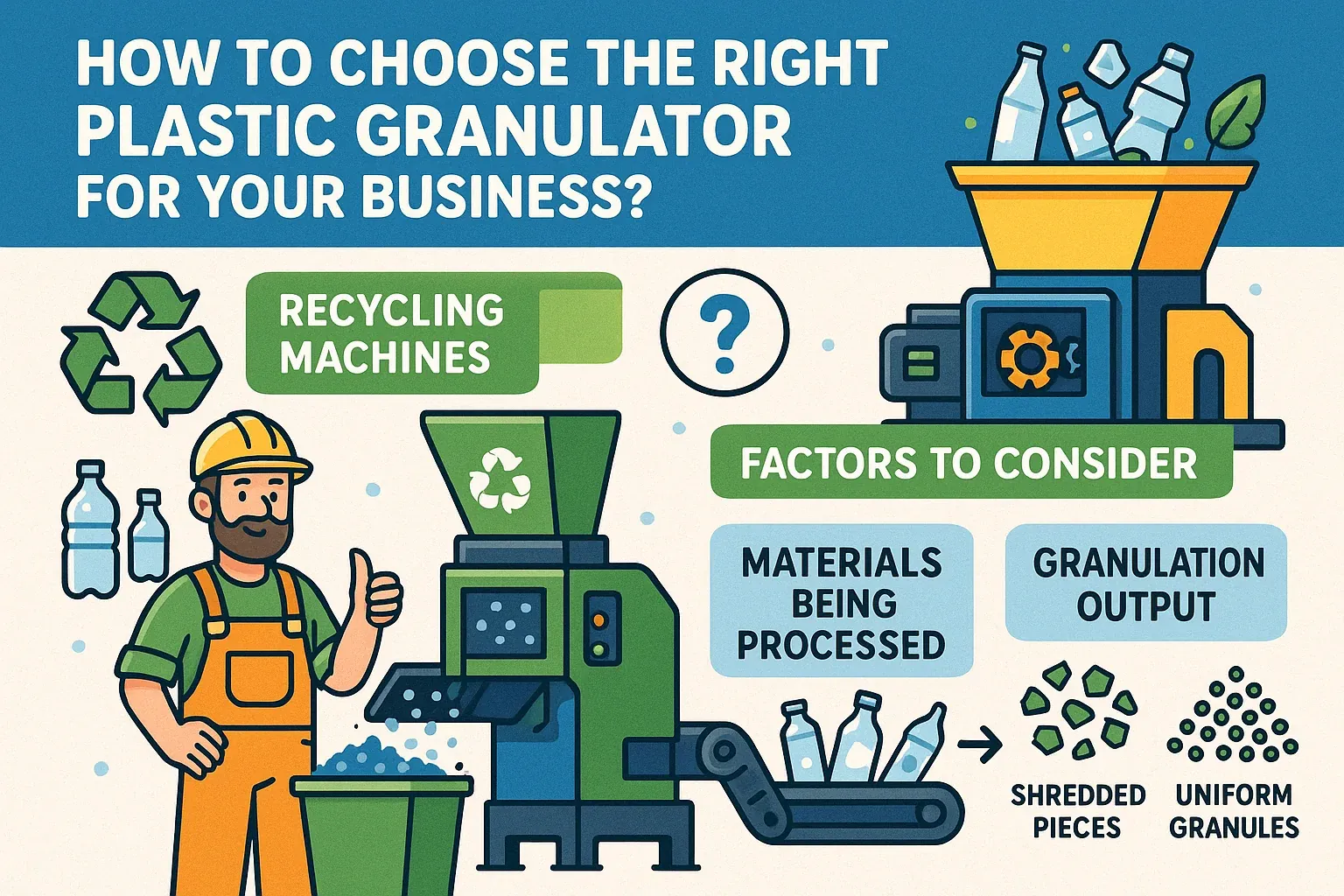In the world of plastic manufacturing and recycling, managing waste efficiently is key to maintaining a sustainable and cost-effective operation. A plastic granulator is an essential tool that helps turn plastic waste into reusable granules, significantly cutting down on costs and environmental impact. With so many options available, choosing the right granulator can be overwhelming. In this guide, we’ll help you navigate the decision-making process, ensuring you select the best plastic granulator that fits your business needs.
Assessing Your Business Needs
Before diving into technical specifications, it’s crucial to understand your specific requirements. Consider the following questions:
- What type of plastic waste do you handle? Bottles, films, pipes, or other materials?
- How much waste do you generate daily or weekly? This determines the required capacity of the granulator.
- What granule size do you need? This will depend on your manufacturing or recycling processes.
By answering these questions, you can narrow down your options and focus on granulators that suit your operational scale and goals.
Types of Granulators and Their Applications
Plastic granulators come in various types, each designed for specific tasks. Understanding the different types can help you choose the right one for your business:
- Granulatory centralne: Large machines designed for high-volume processing. They are perfect for facilities handling diverse materials like bulk plastic scrap and large parts.
- Granulatory przyprasowe: Compact units placed next to molding machines. These granulators are ideal for processing small reject parts, such as sprues and runners, in space-constrained environments.
- Low-Speed Granulators: Operating at slower speeds, these granulators produce less noise and dust. They’re suitable for environments with strict regulations, such as when processing heat-sensitive resins in injection molding.
- Shredder-Granulator Combined: These units offer both shredding and granulating functions in one machine, providing a versatile solution for complex materials and size reduction tasks.
Key Features to Look For
When evaluating granulators, certain features can significantly impact performance and efficiency:
- Rozmiar i pojemność: Ensure the granulator can handle your waste volume, measured in kg/hr or lbs/hr, to match your operational scale.
- Knife Design: The configuration, sharpness, and arrangement of knives impact the quality of the granules produced.
- Cutting Chamber Design: A tangential or straight-drop cutting chamber is essential for efficient handling of bulky parts.
- Funkcje bezpieczeństwa: Look for machines with safety switches, rotor locks, and easy maintenance access to ensure operator safety.
- Łatwość konserwacji: Granulators with tilt-back hoppers and removable screens facilitate quick cleaning and repairs, reducing downtime.
- Noise and Dust Control: Features such as sound insulation and dust separation are crucial in environments with noise and air quality regulations.
- Efektywność energetyczna: Opt for energy-efficient models to reduce long-term operational costs.
- Screen Size and Feed Hopper Design: The screen size will determine the size of your output granules, and the feed hopper design should safely handle larger parts.
Cost Considerations: Balancing Investment and Savings
Plastic granulators vary in cost, ranging from a few hundred to tens of thousands of dollars, depending on size and features. However, it’s important to look beyond the purchase price and consider the total cost of ownership, which includes:
- Installation Costs: Ensure the equipment integrates seamlessly with your existing operations.
- Operating Costs: Consider energy consumption and labor costs when operating the machine.
- Maintenance and Replacement Parts: Factor in regular maintenance, repair costs, and the availability of spare parts.
Some suppliers offer financing options or lease agreements, making it easier to manage upfront costs. Additionally, calculate potential savings from recycling. By reusing granules, you reduce the need for virgin plastic, cutting material costs in the long run.
Choosing a Reputable Supplier
Selecting a reputable supplier is crucial for securing a high-quality granulator and reliable after-sales support. Here’s what to look for:
- Reputation: Opt for suppliers with a solid track record and good customer reviews. Well-known brands such as Energycle are renowned for their reliability and performance.
- After-Sales Support: Ensure the supplier offers technical support, spare parts availability, and warranty coverage. This is vital to minimizing downtime and maintaining long-term machine performance.
- Szkolenie: Suppliers that offer training on machine operation and maintenance can help maximize efficiency and ensure safe use of the equipment.
Regulatory and Environmental Considerations
Before purchasing a granulator, ensure it complies with local safety and environmental regulations, including:
- Noise Levels: Choose low-speed or insulated models for areas with strict noise restrictions.
- Dust Control: Ensure the machine features adequate dust separation to meet air quality standards.
- Operator Safety: Make sure the granulator includes necessary safety features, such as electrical interlocks and emergency stop buttons.
Using a granulator can help your business reduce its environmental footprint by recycling plastic waste. This aligns with market trends toward sustainability and the circular economy, enhancing your brand’s reputation as an environmentally responsible company.
Conclusion: Making the Right Choice
Choosing the right plastic granulator involves understanding your specific needs, evaluating granulator types and features, and considering costs and regulatory requirements. By selecting a machine that fits your operations, you can boost efficiency, reduce costs, and contribute to a greener future. Investing in the right granulator is not just about waste management—it’s about building a sustainable, profitable business.
With Energetyczny, you’ll be equipped to handle your plastic waste effectively while ensuring long-term sustainability. We hope this guide helps you make an informed decision—here’s to a more efficient and environmentally friendly future!



